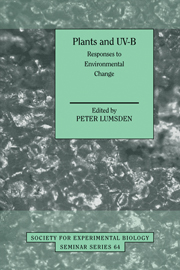Book contents
- Frontmatter
- Contents
- List of contributors
- Preface
- PART I The ozone layer and UV-B radiation
- PART II Effects of UV-B on plants at the cellular level
- PART III Effects of UV-B at the whole plant and community level
- Effects of solar UV-B radiation on aquatic ecosystems
- Assessing the impact of UV-B radiation on the growth and yield of field crops
- Effects of UV-B radiation on plants from agro- and natural ecosystems
- Effects on subarctic vegetation of enhanced UV-B radiation
- Impacts of elevated UV-B on forest ecosystems
- Effects of elevated UV-B radiation and elevated CO2 on heathland communities
- Alterations in competitive balance
- Interations between trophic levels
- Index
Interations between trophic levels
Published online by Cambridge University Press: 04 August 2010
- Frontmatter
- Contents
- List of contributors
- Preface
- PART I The ozone layer and UV-B radiation
- PART II Effects of UV-B on plants at the cellular level
- PART III Effects of UV-B at the whole plant and community level
- Effects of solar UV-B radiation on aquatic ecosystems
- Assessing the impact of UV-B radiation on the growth and yield of field crops
- Effects of UV-B radiation on plants from agro- and natural ecosystems
- Effects on subarctic vegetation of enhanced UV-B radiation
- Impacts of elevated UV-B on forest ecosystems
- Effects of elevated UV-B radiation and elevated CO2 on heathland communities
- Alterations in competitive balance
- Interations between trophic levels
- Index
Summary
Introduction
The effects of UV-B on interactions between plants and their consumers, herbivores and the micro-organisms that cause disease or bring about decomposition of dead tissues, have been the subject of speculation for a number of years (Caldwell et al, 1989), and are increasingly seen to be of potential importance in assessing the consequences of ozone depletion on agriculture and natural ecosystems. Unfortunately, the possible importance of host–consumer interactions in determining the impacts of ozone depletion remain very difficult to assess owing to the scarcity of relevant experimental investigations. It has been hypothesised that increasing UV-B will alter plant–consumer interactions owing to changes in secondary plant metabolism (for example, Caldwell et al., 1995). While this hypothesis points to a rather consistent decrease in herbivory, disease or decomposition, no such consistency is apparent in the few studies which have been published. Indeed, current data tends to highlight the great diversity in responses to UV-B. In this chapter the diversity of responses which have been observed, and the mechanisms which might underlie these variations, will be considered, and will concentrate here on the effects of UV-B on fungi which occur as saprotrophs in the phylloplane and, especially, which cause plant disease, since a) there is slightly more published literature relating to the UV-B responses of these organisms, and b) they have been the main focus of studies at Lancaster.
- Type
- Chapter
- Information
- Plants and UV-BResponses to Environmental Change, pp. 317 - 340Publisher: Cambridge University PressPrint publication year: 1997
- 7
- Cited by

